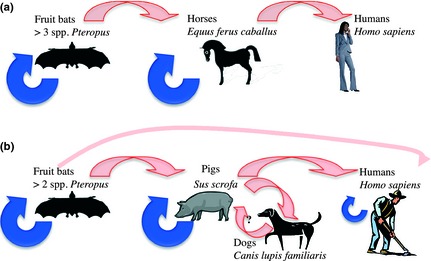Figure 2.

Spillover of two human emerging infectious diseases (EIDs) involving multiple host species. (a) Hendra and (b) Nipah viruses have spilled over into humans from domestic animal reservoirs (horses and pigs respectively), which themselves became infected via spillover from fruit bats (Pteropus spp); pale arrows depict interspecific (including spillover) transmission; dark arrows depict intraspecific transmission (including human intraspecific transmission in the case of Nipah virus). In both cases, increasing contact with bats as a result of farm encroachment and human settlement combined with range expansion of bats fuelled by local habitat destruction are the suspected ultimate causes. Control for both focuses on reducing the contact between the bat reservoir species and domestic stock, for instance, by siting orchards (which attract bats) away from farms. Additional transmission routes for Nipah virus require further control strategies, including education about the risks associated with raw fruit where bats have fed, and rigorous farm and hospital hygiene measures (reviewed in Field, Mackenzie & Daszak 2007).
